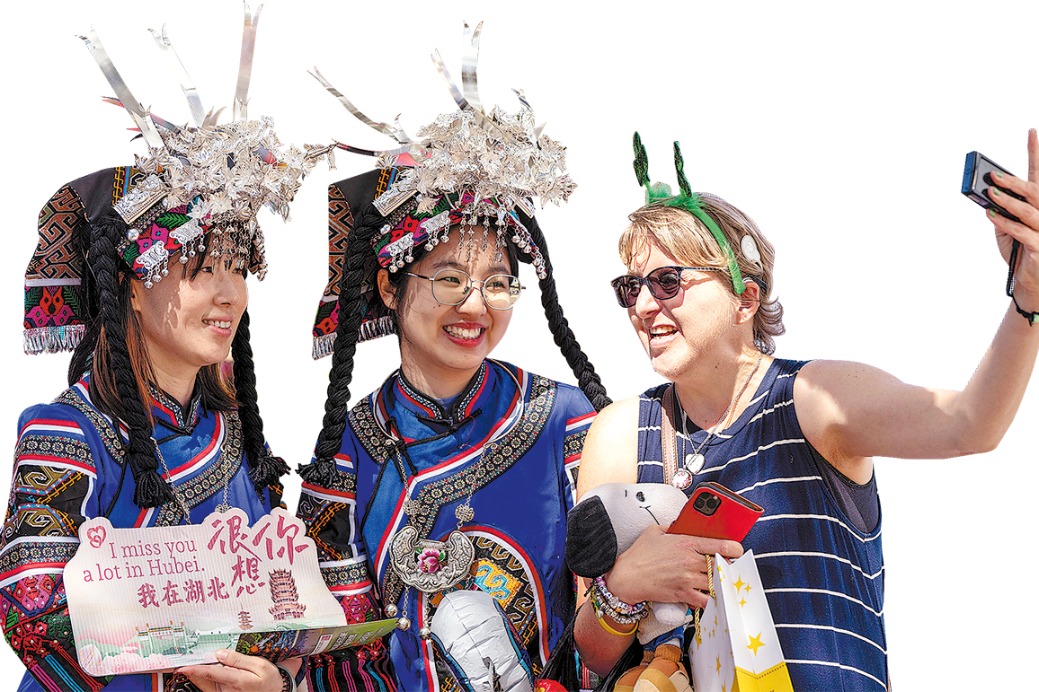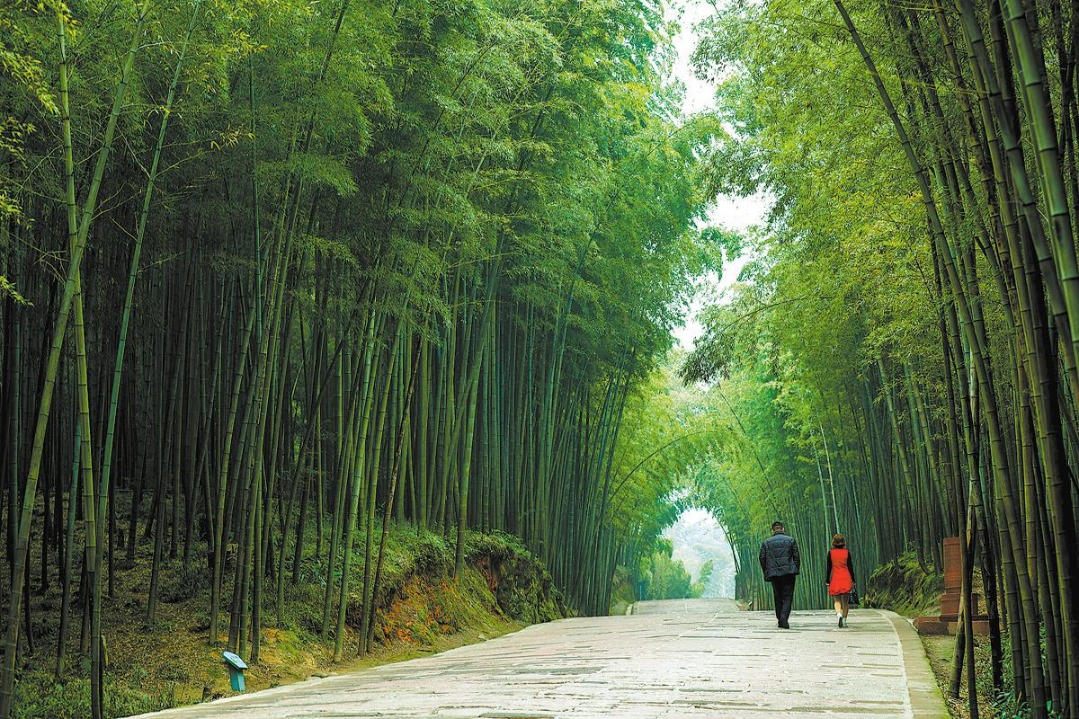Lantern fairs brighten Chinese heritage
Sichuan cities merge tradition with cutting-edge technology, bringing novel experiences to visitors, Huang Zhiling and Peng Chao report in Chengdu.

Min Liuzhou, a primary school student, was pleasantly surprised to spot a certain book during his recent visit to Zigong, Sichuan province.
Unlike the other books in his classroom, this one is a lantern shaped like a book that illuminates the city's lantern fair.
The 10-year-old from Chengdu, Sichuan, is one of the millions of people impressed by the novelties found at this year's lantern festival in Zigong.
The fair began on Jan 17 and ends on May 5, drawing visitors from across China with its gigantic traditional lanterns, which feature the rice harvest, prosperity and auspicious figures found in Chinese mythology.
The event arouses enthusiasm from young visitors like Liuzhou as it pays close attention to the integration and interaction of technology and culture. It uses cutting-edge technologies such as artificial intelligence to produce AI mechanical dinosaur lantern groups, and introduces mobile game IPs like Honor of Kings to create a series of lantern groups.
Viewing lanterns became a Spring Festival tradition in Zigong during the Tang Dynasty (618-907), and lantern fairs are a time-honored Chinese tradition.
"The city's lantern festival has been held in more than 70 countries and regions around the world, becoming Zigong's calling card," says Yang Bin, deputy chief of the publicity department of the Zigong municipal committee of the Communist Party of China.
Zigong Lantern Festival is known as the best in China and its craftsmen have been invited to make lanterns in Chengdu and Sichuan's Miyi county.
In Chengdu's centuries-old Temple of Marquis Wu, also known as the Chengdu Wuhou Shrine, visitors could spot gigantic lanterns in the shape of Zhuge Liang and Guan Yu, two heroes from the Three Kingdoms (220-280) during this year's Spring Festival temple fair, wrapped up on Feb 12.
In the fair's lantern exhibition area, novel designs were seen everywhere. Among them, the naked-eye dynamic hexagonal palace lantern was spectacular, with its pink-hued shape incarnating a "window". Inside the window were lush flowers, leaves and fluttering, feathered emerald bluebirds appearing to fly out.
In addition, visitors could scan a QR code with their mobile phones to hang their prayer lanterns on auspicious trees.
Xiao Yong, a young visitor from Chengdu, says: "This innovative, interactive approach brings a novel experience to people."
The temple is China's only shrine where a subordinate is enshrined with his emperor.
Marquis Wu, or Zhuge Liang (181-234), was a legendary premier and strategist of the Shu Kingdom (221-263) during the Three Kingdoms period.
In Zhuge's youth, the royalty of the Eastern Han Dynasty (25-220) was weak and warlords were entangled in fighting, which led to the country being divided into three kingdoms — Wei, Shu and Wu.
Zhuge, the personification of wisdom and loyalty, helped Liu Bei (161-223), a distant but ambitious relative of the royal family, to establish the Shu Kingdom.
Before Liu's death, he said that if his son proved to be a hopeless and weak-minded person, Zhuge could become the emperor. Liu's son proved to be a poor emperor, but Zhuge offered help instead of dethroning him and eventually died of overwork.
At the time of year, lanterns light up the sky at the Jinsha Site Museum in the western suburbs of Chengdu.
To create a festive atmosphere for visitors during Spring Festival, the local government has sponsored a lantern festival in the garden-like museum, which covers nearly 29 hectares, for 17 consecutive years since 2009.
In the Time Corridor of the museum, visitors find lanterns shaped like colorful flowers.
Near the Ruins Hall, where relics including gold, jade and ivory from the Jinsha Ruins were unearthed after being discovered in 2001, visitors can see lanterns showing the altar of the ancient Shu people with its famous sunbird gold foil. Shu is the ancient name for Sichuan.
The best-known relic is the sunbird gold foil, which National Cultural Heritage Administration adopted in 2005 as China's symbol of cultural heritage.
More than 500 kilometers from the Jinsha Site Museum, a lantern fair that started in late November and ends in late March is being held in Miyi, a county under the administration of Panzhihua in Sichuan.
Unlike those in Chengdu, the lanterns in Miyi are uniquely placed in the spacious Anning River and feature bumper rice harvests and a carp jumping over a dragon gate.
According to Chinese legend, a carp turns into a dragon after jumping over the "dragon gate" in the Yellow River. The legend encourages people to strive for success by studying and working hard, as the Chinese word for "fish" is also a homophone for "abundance" and a symbol of wealth.
According to Wang Yuan, executive director of the publicity department of the Miyi county committee of the CPC, the lantern fair has been held for 15 consecutive years.
The fair starts very early — in November or December, long before Spring Festival — and ends more than a month after the festival, much to the delight of the locals, Wang says.
Miyi, located at the juncture of the Anning and Yalong rivers, is a nationally famous winter resort known for the residents' good health thanks to its annual average temperature of 20 C, daily average sunshine of eight hours, good air quality for more than 352 days a year and forest coverage rate of nearly 65 percent, he adds.



Today's Top News
- SCO summit poised for fruitful outcomes
- Steps to spur consumption, enhance vitality
- Flag patterns for four branches of PLA unveiled
- China seeks to deepen dialogue, consultations with US
- Pacific Ocean should not be turned into a sea of zero-sum disturbances: China Daily editorial
- Xi signs order to commend military units, individuals






























